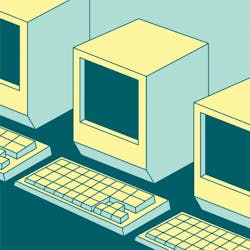“Industrial computers provide the platform longevity that manufacturers require,” claims Shoshana Wodzisz, business manager for industrial computers with controls vendor Rockwell Automation Inc. (www.rockwellautomation.com), Milwaukee. “If a computer needs to be swapped out, the end-user can save hours getting their application software up and running, over an off-the-shelf computer.”One of the past year’s most exciting developments year may be widescreen displays, Wodzisz says. “These displays will change the cutout dimensions significantly in existing enclosures, so that they will likely be more popular for new machine development, rather than as replacements in existing machines.” However, she observes that widescreen displays aren’t yet being widely implemented.A recent state-of-the-art development is fanless industrial computers, making them especially attractive for use in extreme environments, Wodzisz adds. “They are now being developed with components that are able to withstand higher temperatures than ever before.” That allows better reliability and more applications solutions, she adds. “Fanless technology also improves the equipment’s quality, because there are fewer moving parts, and less contamination is being pulled into the computer.” These functionalities will increase the unit’s life.Higher-temperature chip sets—for example, the Atom, an ultra-low-voltage microprocessor developed by Intel—are state-of-the-art developments that enhance industrial computers, Wodzisz notes. “They (high-temperature chip sets) are great for the EOI (electronic operator interface) market.” However, the technology has limited performance, limits random-access memory (RAM) and doesn’t support some peripherals that end-users demand, she notes. “That somewhat diminishes its reach for industrial computers.”One technology, though, that keeps extending its reach is Austin, Texas-headquartered National Instruments Corp.’s (NI, www.ni.com) PXI technology. It is a modular, open, personal computer (PC)-based platform for test, measurement and control that is composed of a chassis, system controller and peripheral modules. There have been several recent developments in the technology’s hardware, including the first-ever Quad-core PXI embedded controller in a 3U form factor—that is, 100 millimeters (mm) by 160 mm—points out Chetan Kapoor, PXI product manager with NI’s automated test group.Kapoor calls this development state-of-the-art. “Typically in the past, due to power-consumption and heat-dissipation limitations, PXI embedded controllers were limited to processors that offered laptop-like CPU (central processing unit) performance.” But over the course of the last couple of years, Intel and AMD have made significant improvements in the silicon-fabrication process that have allowed them to boost the CPU performance, while lowering power consumption and heat dissipation, he remarks. This development has allowed PXI embedded controllers to use processors that offer desktop-like performance in a highly compact form factor.But the development may have an even broader impact. “In the realm of industrial control, a typical control system has one system for managing the control process and another for the user interface,” Kapoor explains. “But by using hardware-assisted virtualization technology, end-users can consolidate both of these systems into a single PXI system employing multi-core PXI embedded controllers.”Software tooBesides hardware improvements, Kapoor also notes “signficant” software developments. “The most important of these is the coming-of-age of software that harnesses the power of hardware-assisted virtualization. Hardware-assisted virtualization is a technology that allows a single CPU to run multiple operating systems concurrently.”As with many aspects of manufacturing, paradigms shift with industrial computers. Wodzisz sees some manufacturers, particularly those in heavily regulated industries or automobile manufacturing, starting to use such computers for factory-floor data logging. Thus, the old standbys find new use, perhaps in kinder environments, but still keep delivering.C. Kenna Amos, [email protected], is an Automation World Contributing Editor. Rockwell Automation Inc.www.rockwellautomation.comNational Instruments Corp., NIwww.ni.com
Subscribe to Automation World's RSS Feeds for Columns & Departments
About the Author
C. Kenna Amos
Contributing Editor
Sign up for our eNewsletters
Get the latest news and updates

Leaders relevant to this article:
